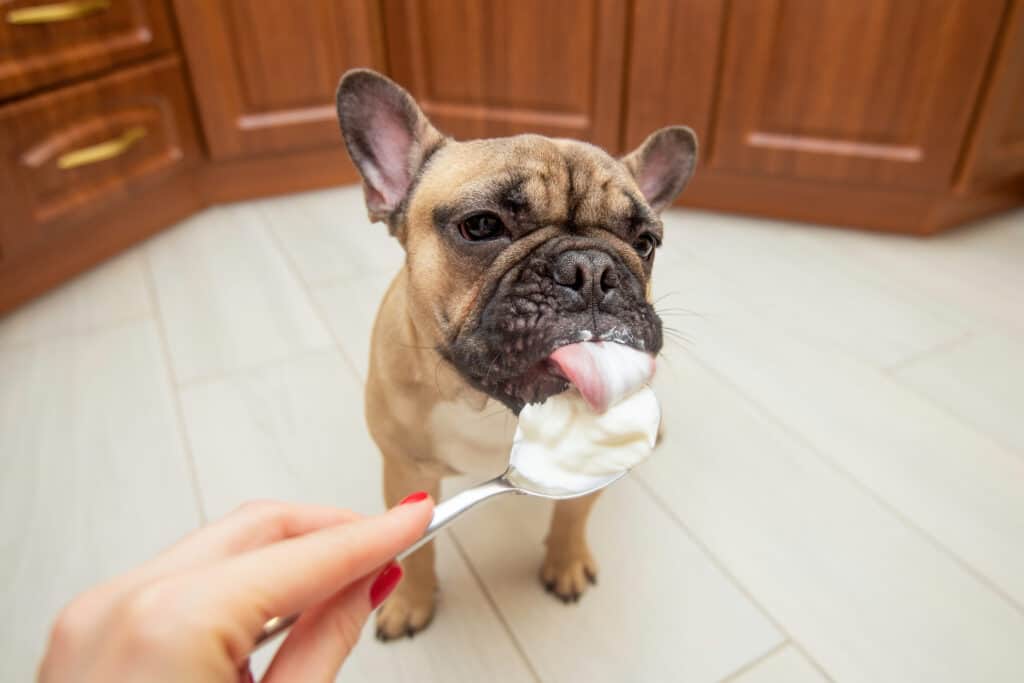Whipped cream puppaccinos are a big trend right now. If you’re wondering what they are and whether they are safe, you’re in the right place! A puppaccino is a small pot of whipped cream you can ask for at a coffee house such as Starbucks. Dogs like them, but can your dog eat whipped cream safely?
Let’s discover whether trendy whipped cream puppaccinos are a good idea.
Is Whipped Cream Safe For Dogs?
Plain whipped cream is safe for dogs in minimal amounts if they don’t have lactose intolerance or pancreatitis. Still, it’s a bad idea if the dog is overweight because whipped cream is high in calories.
Whipped cream is a high-fat food. It can also contain sugar, xylitol, and other harmful ingredients like chocolate. If grabbing a puppaccino at the drive-thru, ensure you know the ingredients before your dog gets anywhere near the cup. Plain whipped cream is what you’re looking for.
What Is Whipped Cream?
Whipped cream is liquid and whisked to form a solid mass. Commercially sold whipped cream is often sweetened with sugar, vanilla, cinnamon, chocolate or artificial sweeteners.
Whipped cream is also available in aerosol cans, such as the common brand name Reddi-Wip. Different versions include low-fat, plant-based, and dairy-free brands known as the whipped top.
Historians have found whipped cream mentioned in literature dating back to the 1500s. Our ancestors called it cream snow and ate it with fruits and liqueurs. Perhaps they fed it to their dogs too!
What Is A Puppaccino?
A play on the word cappuccino, puppuccinos are small cups filled with whipped cream for pups. Starbucks began the trend in their drive-thrus, and other coffee houses now offer their pup cups.
Puppaccinos are a big hit on social media, with influencers filming their dogs downing whipped cream with relish. As a rare little treat, this isn’t a problem, but frequent pup cups can cause problems.
Are Puppaccinos Safe For Dogs?

Yes, plain whipped cream puppaccinos are safe for dogs in moderation unless your dog is obese, lactose intolerant, or has pancreatitis.
©Ericaaa/Shutterstock.com
Yes, plain whipped cream puppaccinos are safe for dogs in moderation unless your dog is obese, lactose intolerant, or has pancreatitis.
Starbucks gives puppaccinos away free as part of their secret menu, but this doesn’t mean you should go there every day as the calories will mount up. It’s also crucial that the puppaccino is just plain cream with no flavorings, added sugar, and no toxic Xylitol. More on that later.
Benefits of Whipped Cream
Heavy whipped cream (the full-fat type, not light or plant-based creams) is calorie-dense. Still, it does contain a few surprising health benefits, including a host of fat-soluble vitamins.
Fat-soluble vitamins use body fat to dissolve and release their nutrients. They include:
- Vitamin A – essential for eye health, boosts the immune system. It’s also an antioxidant
- Vitamin D – boosts bone, teeth, and nail health
- Vitamin E – great for healthy skin and glossy coats
- Vitamin K – supports red blood cells and blood clotting
Cream also contains these nutrients:
- Tryptophan – soothes stress and boosts the immune system
- Calcium – essential for strong bones and teeth
- Riboflavin – helps turn food into energy
- Phosphorus – repairs and maintains tissues and cells
Whipped cream can also be a helpful way to help underweight dogs gain pounds, and because they love the taste, it’s a helpful training tool for food-motivated dogs.
Can Dogs Eat Whipped Cream: Risks
- ORIJEN Original dog food delivers a diet rich and varied in fresh, whole animal ingredients from free-run chicken and turkey, wild-caught fish, and cage-free eggs
- With 85% quality animal ingredients, ORIJEN nourishes dogs according to their natural, biological needs
- Using fresh and raw animal ingredients, including meat, organs, cartilage, and bone, ORIJEN is the Biologically Appropriate, grain-free diet that dogs have evolved to eat
- Our Fresh Regional Ingredients are supplied by people we know and trust, and are delivered to our kitchen fresh or raw, in their most natural and nourishing form
Cream isn’t toxic for dogs and has plenty of health benefits, but there are some risks, and it’s not just obesity!
Let’s start with the calorie content as it’s the most obvious risk.
Cream is high in calories
Cream is the fatty part of milk produced to help young animals such as calves (and human children) grow. As a result, it is calorie dense, and even a small amount each day can tip dogs into obesity.
Obesity is a real problem for dogs in the States. According to the Association for Pet Obesity Prevention, 56% of pet dogs are overweight or obese. This can lead to serious health issues like diabetes, joint mobility, increased risk of cancer, and pancreatitis.
Pancreatitis is a disease that affects the pancreas. The pancreas is a small organ near the stomach, and its main job is to produce enzymes that break down fat, starch, and sugar. It also helps produce hormones.
A high-fat diet causes pancreatitis. The pancreas gets inflamed and starts producing enzymes without ingestion of food. It is painful, damaging, and not something you’d want for your dog.
Lactose Intolerance
Some dogs cannot digest lactose found in dairy products. The symptoms of lactose intolerance are:
- Diarrhea
- Vomiting
- Itchy skin
- Flatulence
- Ear and eye infections
- Lethargy
- Stomach pains
- Failure to thrive and enjoy life
If you’ve never given your dog a dairy product before, try them on a small amount of milk and see how they react. Don’t give them whipped cream, pouring cream, cheese, milk, or anything with dairy products if they develop symptoms.
Flavorings
Whipped cream is often sold commercially with extra sugar, xylitol or sweeteners like honey, vanilla or cinnamon, which is a problem for dogs.
Xylitol is an artificial sweetener that creates a massive drop in blood sugar that can lead to hypoglycemia. While sugar is not toxic, dogs shouldn’t eat it regularly. Not only is sugar a carbohydrate that quickly turns to fat, but it also creates tooth decay the same way it does in humans.
How To Feed Whipped Cream To A Dog Safely
A small amount of plain unsweetened whipped cream like a sugar-free and xylitol-free puppuccino is unlikely to harm your pooch unless it’s lactose intolerant or has pancreatitis.
Although whipped cream is highly fattening, the best way to treat your dog is by whipping plain cream at home in a food mixer or by hand. That way, you can be sure it doesn’t contain any extra flavoring.
My Dog Ate Whipped Cream What Do I Do?

Feed your puppy small meals of turkey and sweet potato, or the old favorite rice and chicken, to settle stomach aches and firm up stools.
©chanonnat srisura/Shutterstock.com
It depends.
Suppose the label indicates the whipped cream has Xylitol, chocolate, or other artificial sweeteners. In that case, it’s best to call your vet immediately. The same applies if your dog has suffered from pancreatitis in the past.
If, however, healthy Lassie stole a bowl of plain whipped cream from the kitchen counter, it may upset their stomach. Still, it’s unlikely to have lasting effects.
Feed your puppy small meals of turkey and sweet potato, or the old favorite rice and chicken, to settle stomach aches and firm up stools. If diarrhea lasts more than a few days, consult your vet.
How Much Whipped Cream is Safe for Dog?
A Starbucks puppuccino is around one to two ounces of whipped cream, which some experts say is safe for dogs as long as it doesn’t become a habit.
The ASPCA suggests treat foods make up no more than 10% of a dog’s daily diet, and the rest should be a good quality commercial or homemade dog food with all the nutrients they need.
10% is a small amount, but feeding 10% whipped cream each day will lead to obesity in even the most active of dogs.
What Foods Are Toxic For Dogs?
Dogs can eat whipped cream, but there are dangerous foods that are highly toxic. They include grapes, chocolate, macadamia nuts, black walnuts, Xylitol (in some cakes, biscuits, jelly sweets, and Jell-o), onions, garlic, and avocados.
If your dog eats any of these, call your veterinarian right away.
What Snacks Are Healthy For Dogs?
Whipped cream should be saved for an occasional treat because there are snack foods that are much healthier for your dog.
These include carrot sticks, apple slices, blueberries, soybeans, and bell peppers.
Up Next
- Can Dogs Be Vegan? What Are The Risks?
- Can Dogs Eat Ginger, Should They?
- Can Dogs Eat Cottage Cheese? Is it Healthy?
The photo featured at the top of this post is © Ericaaa/Shutterstock.com
Ready to discover the top 10 cutest dog breeds in the entire world?
How about the fastest dogs, the largest dogs and those that are -- quite frankly -- just the kindest dogs on the planet? Each day, AZ Animals sends out lists just like this to our thousands of email subscribers. And the best part? It's FREE. Join today by entering your email below.
Sources
- NCBI, Available here: https://www.ncbi.nlm.nih.gov/books/NBK218749
- ASPCA, Available here: https://www.aspca.org/news/top-five-summer-activities-you-and-your-pet
- ASPCA, Available here: https://www.aspca.org/pet-care/dog-care/dog-nutrition-tips
Thank you for reading! Have some feedback for us? Contact the AZ Animals editorial team.







